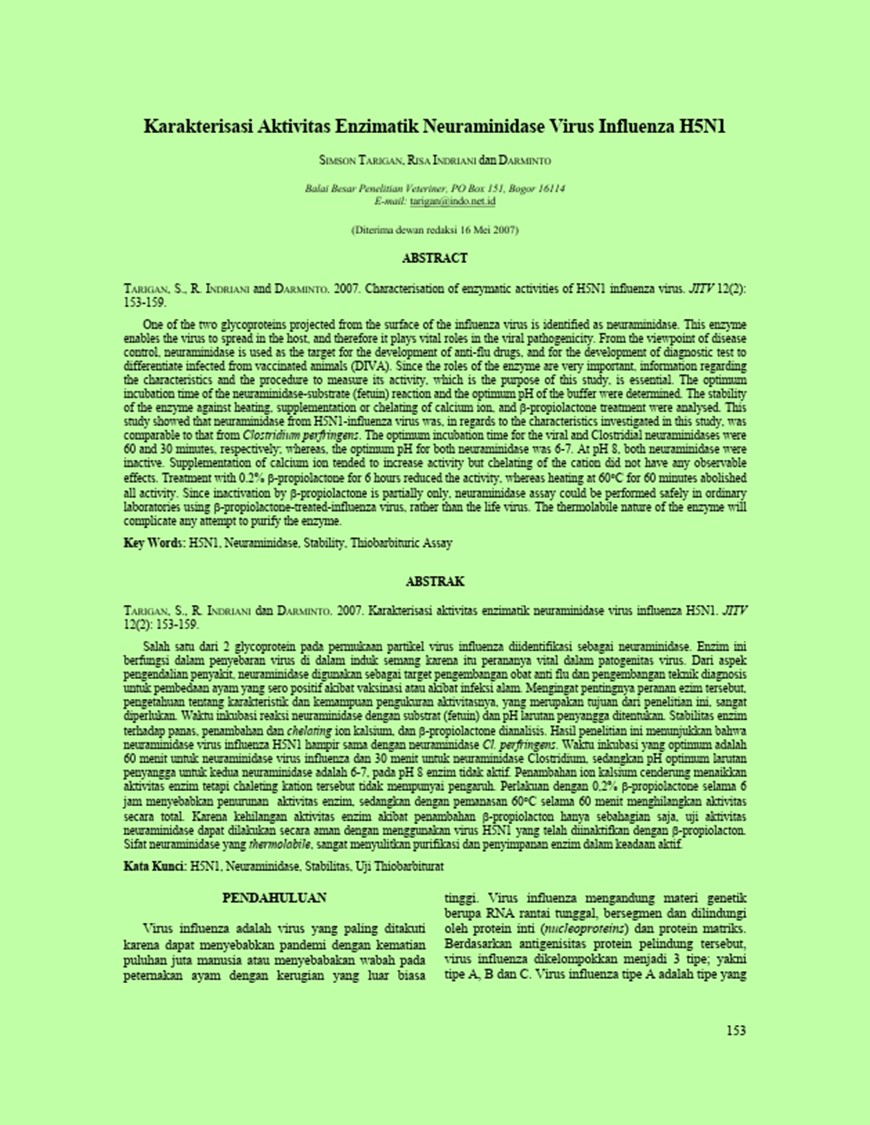
| Judul | Karakterisasi Aktivitas Enzimatik Neuraminidase Virus Influenza H5N1 / SIMSON TARIGAN |
| Pengarang | SIMSON TARIGAN RISA INDRIANI DARMINTO |
| EDISI | Vol. 12 No. 2 |
| Penerbitan | Balai Besar Penelitian Veteriner : JITV, 2007 |
| Deskripsi Fisik | 7 |
| Subjek | Enzimatik Neuraminidase |
| Abstrak | One of the two glycoproteins projected from the surface of the influenza virus is identified as neuraminidase. This enzyme enables the virus to spread in the host, and therefore it plays vital roles in the viral pathogenicity. From the viewpoint of disease control, neuraminidase is used as the target for the development of anti-flu drugs, and for the development of diagnostic test to differentiate infected from vaccinated animals (DIVA). Since the roles of the enzyme are very important, information regarding the characteristics and the procedure to measure its activity, which is the purpose of this study, is essential. The optimum incubation time of the neuraminidase-substrate (fetuin) reaction and the optimum pH of the buffer were determined. The stability of the enzyme against heating, supplementation or chelating of calcium ion, and ?-propiolactone treatment were analysed. This study showed that neuraminidase from H5N1-influenza virus was, in regards to the characteristics investigated in this study |
| Bentuk Karya | Tidak ada kode yang sesuai |
| Target Pembaca | Tidak ada kode yang sesuai |
| No Barcode | No. Panggil | Akses | Lokasi | Ketersediaan |
|---|---|---|---|---|
| ARTVET2339 | ARTVET2339 | Dapat dipinjam | Perpustakaan Balai Besar Perakitan dan Modernisasi Veteriner - Ruang Baca Umum | Tersedia |
| Tag | Ind1 | Ind2 | Isi |
| 001 | INLIS000000000019056 | ||
| 005 | 20250203082304 | ||
| 007 | ta | ||
| 008 | 250203################|##########|#|## | ||
| 035 | # | # | $a 0010-0924000135 |
| 082 | # | # | $a ARTVET2339 |
| 084 | # | # | $a ARTVET2339 |
| 100 | 0 | # | $a SIMSON TARIGAN |
| 245 | 1 | # | $a Karakterisasi Aktivitas Enzimatik Neuraminidase Virus Influenza H5N1 /$c SIMSON TARIGAN |
| 250 | # | # | $a Vol. 12 No. 2 |
| 260 | # | # | $a Balai Besar Penelitian Veteriner :$b JITV,$c 2007 |
| 300 | # | # | $a 7 |
| 520 | # | # | $a One of the two glycoproteins projected from the surface of the influenza virus is identified as neuraminidase. This enzyme enables the virus to spread in the host, and therefore it plays vital roles in the viral pathogenicity. From the viewpoint of disease control, neuraminidase is used as the target for the development of anti-flu drugs, and for the development of diagnostic test to differentiate infected from vaccinated animals (DIVA). Since the roles of the enzyme are very important, information regarding the characteristics and the procedure to measure its activity, which is the purpose of this study, is essential. The optimum incubation time of the neuraminidase-substrate (fetuin) reaction and the optimum pH of the buffer were determined. The stability of the enzyme against heating, supplementation or chelating of calcium ion, and ?-propiolactone treatment were analysed. This study showed that neuraminidase from H5N1-influenza virus was, in regards to the characteristics investigated in this study, was comparable to that from Clostridium perfringens. The optimum incubation time for the viral and Clostridial neuraminidases were 60 and 30 minutes, respectively; whereas, the optimum pH for both neuraminidase was 6-7. At pH 8, both neuraminidase were inactive. Supplementation of calcium ion tended to increase activity but chelating of the cation did not have any observable effects. Treatment with 0.2% ?-propiolactone for 6 hours reduced the activity, whereas heating at 60°C for 60 minutes abolished all activity. Since inactivation by ?-propiolactone is partially only, neuraminidase assay could be performed safely in ordinary laboratories using ?-propiolactone-treated-influenza virus, rather than the life virus. The thermolabile nature of the enzyme will complicate any attempt to purify the enzyme. |
| 650 | # | 4 | $a Enzimatik Neuraminidase |
| 700 | 0 | # | $a DARMINTO |
| 700 | 0 | # | $a RISA INDRIANI |
| 990 | # | # | $a ARTVET2339 |
| No | Nama File | Nama File Format Flash | Format File | Action |
| 1 | 1334.pdf | ARTVET1334 | Baca Online |
Content Unduh katalog
Karya Terkait :